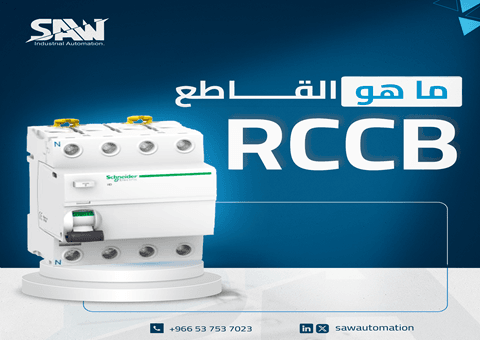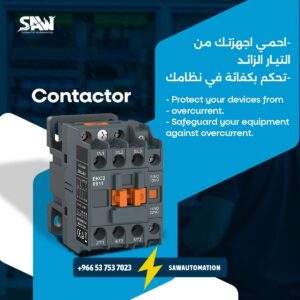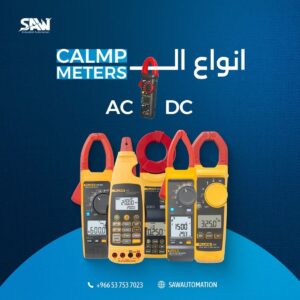What is an RCCB and its Uses

What is an RCCB and its uses
Saw automation & electrical parts
The RCCB is one of the well-known electrical circuit breakers that protects electrical systems from ground leakage and faults in various applications, whether residential, commercial, or industrial. In today’s article, we will discuss the RCCB, its mechanism of operation, its role in electrical systems, and its most common uses.
What is an RCCB?
The RCCB is one of the most famous electrical circuit breaker tools. It works to detect the presence of ground leakage of electrical current and consequently disconnects the power from the electrical circuit to avoid electric shocks or fires, making it an important tool in enhancing the safety of the electrical system.
This breaker is distinguished from other electrical circuit breakers in that it provides essential protection for individuals and equipment from electrical faults, which can lead to fire hazards or shocks, by immediately disconnecting the power from the circuit when detecting a fault in the current.
There are many types of RCCBs, with the double-pole and four-pole types being among the most common. The double-pole type is the most suitable option for residential applications because they do not rely on three-phase electrical systems. The four-pole type is more suitable for industrial and commercial applications because it is equipped with a more complex protection system.
What is the function of RCCB in electricity?
One of the frequently asked questions about the RCCB is “What is the function of RCCB in electricity?” We answer that its main function is to provide protection and safety for electrical systems in case of faults, ensuring the protection of individuals and equipment from potential electrical hazards.
This breaker operates on the principle of detection and response by detecting residual currents to identify faults or leakage. If detection occurs, the electrical circuit is immediately disconnected. The main components of this breaker are the main mechanism, sensing coils, and tripping mechanism.
The main mechanism of the breaker allows for the detection of residual currents, thanks to the neutral and live conductors surrounding it. The sensing coils generate a magnetic field proportional to the conductors. In case of current imbalance, a magnetic field is produced in the toroidal core due to the residual currents.
In this case, the magnetic field resulting from the current imbalance is expected to activate the tripping mechanism to perform its main role of quickly disconnecting the electrical circuit. This helps limit damage or material or human losses and provides the necessary protection for electrical systems.
The difference between RCCB and RCBO
There are many types of ground fault circuit breakers, with RCCB and RCBO being among the most famous. Therefore, we will highlight the difference between RCCB and RCBO from several aspects, which are:
In general
RCCB is a breaker specifically designed to provide necessary protection against ground leakage in electrical circuits, while RCBO is specifically designed to provide protection against ground leakage, short circuits, and overload currents because it combines the characteristics of both RCCB and MCB breakers.
Main function
The main function of the RCCB is to provide protection against ground leakage, thus reducing the risks of electric shocks and fires. As for the function of RCBO, it is a compound function consisting of dual protection against ground leakage as well as protection against short circuits and overload.
Working mechanism
There is also a difference between RCCB and RCBO in terms of the working mechanism. The working mechanism in RCCB is based on comparing the value of the incoming current with the value of the outgoing current. If there is a difference between the two values, it indicates a leakage problem outside the original circuit, and consequently, the circuit is disconnected.
As for the working mechanism of RCBO, it also involves measuring the difference between the incoming and outgoing current values with sensitivity levels similar to RCCB. However, it is equipped with higher amperage capacities resulting from the MCB breaker, which helps provide protection against overcurrents or short circuits.
Installation method
We can say that RCBO is easier to install as it does not need to be installed with an MCB breaker, while RCCB needs to be installed with an MCB. This also requires providing sufficient space inside the distribution panel to include both breakers together.
Financial cost
Looking at the financial cost, we find that RCCB is less expensive, making it a suitable option for those looking for economical options in providing protection against ground leakage. While the cost of RCBO is higher because it also contains an MCB breaker and provides additional protection features.
Does installing an RCCB eliminate the need for electrical grounding?
There are many questions about the function of the RCCB, including the question “Does installing an RCCB eliminate the need for electrical grounding?” We will answer this. First, the electrical grounding system is a system that works to discharge excess electrical charges to the ground.
The importance of the electrical grounding system lies in providing protection for individuals from electric shocks, protecting devices from damage caused by overloads, providing stability for electrical voltage, and the ability to accurately measure electrical voltage. It is an important part of the electrical system and must be installed according to the required specifications and standards.
We answer this question by saying that despite the importance of installing the RCCB with a number of electrical devices to ensure the prevention of ground leakage, which may pose a danger, especially if the electrical system does not include a grounding system, or if the grounding is dilapidated or old.
However, we cannot completely dispense with the electrical grounding system, but it is considered an additional feature that contributes to maintaining the safety of the electrical system. Therefore, care must be taken to provide an integrated ground grounding system in order to achieve higher levels of protection and safety when operating the electrical system.
Where should RCCB be used?
After we have learned what an RCCB is and how it works, we still need to know where RCCB should be used. Its areas of use are wide, and you can use it in one of the following applications:
Industrial applications
RCCB is relied upon in industrial facilities to reduce the risks of potential ground leakage due to equipment damage, ground faults, or electrical wire damage. RCCB detects these leaks and faults and disconnects the circuit immediately at a speed that may reach 40 milliseconds.
Commercial applications
Commercial facilities also ensure the use of RCCB breakers to provide protection against ground leakage, fire hazards, electric shock, and equipment maintenance from changes in flowing currents, by quickly disconnecting the electrical circuits causing this malfunction.
Their importance in commercial facilities is to provide the necessary protection for individuals, equipment safety from overloads and leakage, extend their lifespan, save financial costs spent on frequent maintenance operations, and reduce downtime due to frequent breakdowns.
Medical applications
Some medical applications may need to provide the necessary protection against ground leakage, which may negatively affect the safety of sensitive equipment and tools. Here, RCCB breakers play their role in isolating the electrical circuit if a fault is detected in the balance of residual currents, which contributes to maintaining their safety.
Choosing the appropriate RCCB breaker is essential to provide the necessary protection for individuals and equipment. You can choose the appropriate breaker according to the type of applications, the required sensitivity level, the brand, the quality of the breaker, and also the financial cost to ensure reliability and safety.




